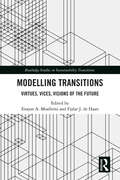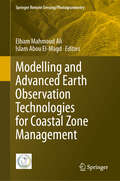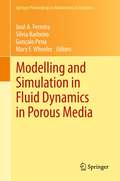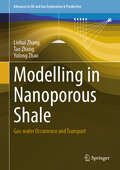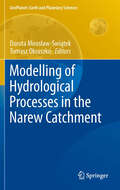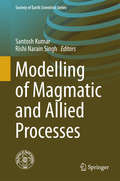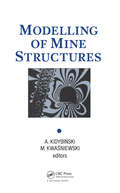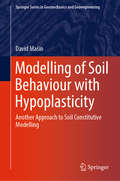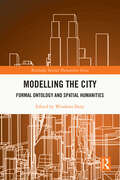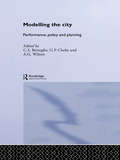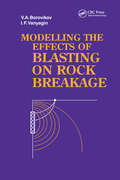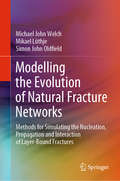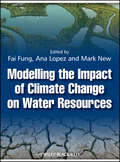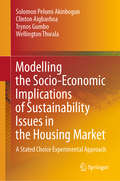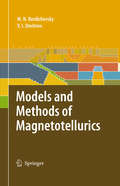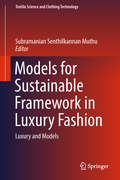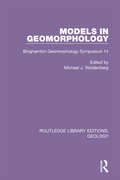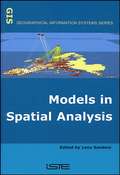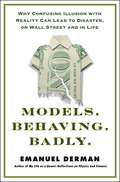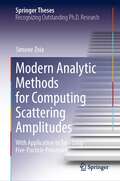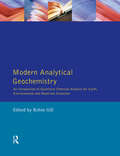- Table View
- List View
Modelling Transitions: Virtues, Vices, Visions of the Future (Routledge Studies in Sustainability Transitions)
by Enayat A. Moallemi Fjalar J. de HaanModelling Transitions shows what computational, formal and data-driven approaches can and could mean for sustainability transitions research, presenting the state-of-the-art and exploring what lies beyond. Featuring contributions from many well-known authors, this book presents the various benefits of modelling for transitions research. More than just taking stock, it also critically examines what modelling of transformative change means and could mean for transitions research and for other disciplines that study societal changes. This includes identifying a variety of approaches currently not part of the portfolios of transitions modellers. Far from only singing praise, critical methodological and philosophical introspection are key aspects of this important book. This book speaks to modellers and non-modellers alike who value the development of robust knowledge on transitions to sustainability, including colleagues in congenial fields. Be they students, researchers or practitioners, everyone interested in transitions should find this book relevant as reference, resource and guide.
Modelling Tropospheric Volcanic Aerosol
by Anja SchmidtAnja Schmidt's thesis is a unique and comprehensive evaluation of the impacts of tropospheric volcanic aerosol on the atmosphere, climate, air quality and human health. Using a state-of-the-art global microphysics model, the thesis describes and quantifies the impact of volcanic sulphur emissions on global aerosol, clouds and the radiative forcing of climate. The advanced model enables the first ever estimate of the impact of the emissions on aerosol microphysical properties such as particle number concentrations and sizes, and therefore a considerably improved ability to quantify the climate and air quality effects. There are several important discoveries in this thesis. Firstly, it is shown that continuously degassing volcanoes exert a major effect on global clouds and climate. Secondly, the impact of the 1783 Laki eruption in Iceland is re-examined to show that this long-lasting flood lava eruption would have had major effects on clouds and climate. Thirdly, by combining her research on volcanism, atmospheric science and epidemiology, she shows that a present-day Laki-like eruption would seriously affect European air quality and cause over 100000 premature deaths in the first year.
Modelling and Advanced Earth Observation Technologies for Coastal Zone Management (Springer Remote Sensing/Photogrammetry)
by Elham Mahmoud Ali Islam Abou El-MagdThis volume provides readers with the tools to unlock the potential of Earth observation (EO) technologies to transform coastal zone management. This comprehensive guide delves into how EO technologies can be used monitor and manage coastal areas, emphasizing sustainable land use and development. Designed for researchers, decision-makers, and environmental planners, this book offers multi-scale assessment approaches that provide actionable solutions and strategic plans for managing extensive environmental landscapes. Readers will discover innovative management solutions for a variety of environmental challenges, along with new methodologies aimed at sustainable development and the achievement of the United Nations Sustainable Development Goals (SDGs) and 2030 targets. This volume showcases numerous multi-tasked applications of satellite data from diverse sources, validating the immense value of earth observations in environmental management. By integrating this data into geographical databases, the book provide an ideal framework for spatial planning at various scales. Geospatial information is a crucial tool for creating interactive systems for spatial analysis, merging real-world data with forecasting models to support social and economic development. Geospatial information guides where and when to act, aiding in the development of strategic and implementation plans that promote sustainable development. Embrace the future of coastal zone management with this volume and equip yourself with the knowledge and tools to make informed, impactful decisions for a sustainable tomorrow.
Modelling and Simulation in Fluid Dynamics in Porous Media
by Gonçalo Pena Mary F. Wheeler José A. Ferreira Sílvia BarbeiroThis volume presents a selection of survey and research articles based on invited lectures and contributed talks presented at the Workshop on Fluid Dynamics in Porous Media that was held in Coimbra, Portugal, in September 12-14, 2011. The contributions are devoted to mathematical modeling, numerical simulation and their applications, providing the readers a state-of-the-art overview on the latest findings and new challenges on the topic. The book includes research work of worldwide recognized leaders in their respective fields and presents advances in both theory and applications, making it appealing to a vast range of audience, in particular mathematicians, engineers and physicists.
Modelling and Simulation in Science, Technology and Engineering Mathematics: Proceedings Of International Conference On Modelling And Simulation (ms-17) (Advances In Intelligent Systems and Computing #749)
by Surajit Chattopadhyay Samarjit Sengupta Christian Berger-Vachon Tamal RoyThis volume contains the peer-reviewed proceedings of the International Conference on Modelling and Simulation (MS-17), held in Kolkata, India, 4th-5th November 2017, organized by the Association for the Advancement of Modelling and Simulation Techniques in Enterprises (AMSE, France) in association with the Institution of Engineering Technology (IET, UK), Kolkata Network. The contributions contained here showcase some recent advances in modelling and simulation across various aspects of science and technology. This book brings together articles describing applications of modelling and simulation techniques in fields as diverse as physics, mathematics, electrical engineering, industrial electronics, control, automation, power systems, energy and robotics. It includes a special section on mechanical, fuzzy, optical and opto-electronic control of oscillations. It provides a snapshot of the state of the art in modelling and simulation methods and their applications, and will be of interest to researchers and engineering professionals from industry, academia and research organizations.
Modelling in Nanoporous Shale: Gas-water Occurrence and Transport (Advances in Oil and Gas Exploration & Production)
by Tao Zhang Liehui Zhang Yulong ZhaoThis book addresses the problems involved in the modelling and simulation of shale gas reservoirs at pore scale, and details recent advances in the field. It presents the construction of simulation methods, mainly using the lattice Boltzmann method (LBM), that describe sorption, flow, and transport in nanoporous shale with some case studies. This book highlights the nanoscale effects, ascribed to the large surface-to-volume ratio, on fluids occurrence and transport physics. It discusses some interesting phenomena occurs at nanoporous shale, such as absorbed water film, water condensation, sorption hysteresis, surface excess adsorption, Knudsen diffusion, surface diffusion, structural fluid density, no-slip boundary, etc. The key techniques and methods introduced in this book provide the basis for accurate prediction of gas-well productivity. The basic principles and modeling methods are also relevant to many other nanoporous applications in science and engineering. The book aims to provide a valuable reference resource for researchers and professional scientists and engineers working on shale gas development and nanoporous media research.
Modelling of Hydrological Processes in the Narew Catchment
by Dorota Świątek Tomasz OkruszkoSince climate and land use strongly affect the runoff pattern and intensity of solute export, it is likely that some observations and conclusions formulated on the basis of investigations carried out in forested catchment may not be fully adequate to describe controls on solute export from agricultural watersheds. The primary objective of the present research is to better understand the flow paths that affect the fluxes of dissolved compounds from a small agricultural catchment during snowmelt. This book focuses on spring snowmelt, because this is the dominant hydrological event in many moderate and high latitude catchments and, thus, is regarded as a prominent factor influencing the quality of surface waters
Modelling of Magmatic and Allied Processes
by Santosh Kumar Rishi Narain SinghModeling of Magmatic and Allied Processes presents methods and models for the quantification of geological processes. Conceptual models for magmatic differentiation involving crystallization and mixing are presented and applied to field and textural data. Model equations for the degree of partial melting in presence perturbations of lithospheric geotherms and partitioning of trace/radioactive elements in the matrix and melts, and the formation of continents with melt additions are described. Diverse magmatic products are shown to result from differentiation processes rather than magmatic source heterogeneities. The degree of partial melting depends on mantle temperatures, for which parameterized thermal convection models are reviewed. Perturbations in geotherms caused by mantle heat flow, CO2 flux from great depths and tectonic thrusting are analyzed. The petrogenetic significance of accessory minerals of felsic magma evolution is assessed with the help of examples from Carpathian granitoids. Methods for simulating the 3-D Concentration and Distribution Models (DC-DMs) and fractal dimension of evolving magma systems are described with examples. The use of conventional scanning electron microscopy methods and electron microprobe to characterize and infer magmatic processes is explained, and the background and economic potential of hydrothermal systems are examined. The nature of oxidizing felsic magmas along with their potential for copper mineralization is discussed. In closing, the handling, calculation and plotting of geochemical data for igneous rock suites using the R-language-based software Geochemical Data Toolkit (GCDkit) along with plug-in modules for the forward and reverse mass-balance calculation of fractional crystallization are demonstrated.
Modelling of Mine Structures: Proceedings of the 10th plenary session of the International Bureau of Strata Mechanics, World Mining Congress, Stockholm, 4 June 1987
by A.KIDYBIŃSKI; M.KWAŚNIEWSKIProceedings of the 10th Plenary Scientific Session of the International Bureau of Strata Mechanics, World Mining Congress, Stockholm, June 1987.
Modelling of Soil Behaviour with Hypoplasticity: Another Approach to Soil Constitutive Modelling (Springer Series in Geomechanics and Geoengineering)
by David Mašín<p>This book explains the hypoplastic modelling framework. It is divided into two parts, the first of which is devoted to principles of hypoplasticity. First, the basic features of soil’s mechanical behaviour are introduced, namely non-linearity and asymptotic properties. These features are then incorporated into simple one-dimensional hypoplastic equations for compression and shear. Subsequently, a hypoplastic equivalent of the Modified Cam-Clay model is developed in 2D space using stress and strain invariants to demonstrate key similarities and differences between elasto-plastic and hypoplastic formulations. Lastly, the mathematical structure of hypoplastic models is explained by tracing their historical development, from the early trial-and-error models to more recent approaches. In turn, Part II introduces specific hypoplastic models for soils. First, two reference models for sand and clay are defined. After summarising their mathematical formulations, calibration procedures are described and discussed. Subsequently, more advanced modelling approaches are covered: the intergranular strain concept incorporating the effects of small strain stiffness and cyclic loading, viscohypoplasticity for predicting rate effects, soil structure to represent structured and bonded materials and soil anisotropy. The book concludes with a description of partial saturation and thermal effects: topics that are increasingly important to the disciplines of energy and environmental geotechnics. <p>Selecting a constitutive model and its parameters is often the most important and yet challenging part of any numerical analysis in geotechnical engineering. Hypoplasticity involves a specific class of soil constitutive models, which are described in detail here. The book offers an essential resource, both for model users who need a more advanced model for their geotechnical calculations and are mainly interested in parameter calibration procedures, and for model developers who are seeking a comprehensive understanding of the mathematical structure of hypoplasticity.</p>
Modelling the City: Formal Ontology and Spatial Humanities (Routledge Spatial Humanities Series)
by Wiesława DużyModelling the City focuses on European towns and cities, analysing the opportunities and limitations of modelling of urban space.This book examines how urban space from the past is discovered, explained and presented. It discusses the multitude of historical sources mediating the past urban space, and the structural, technical, and epistemological issues raised around building a domain ontology, including continuity, and change within urban forms and functions.Presentation of a formal domain ontology in spatial humanities makes this book unique and worth reading. It is strongly recommended to readers interested in the linked open data approach to research, data standards in Digital Humanities, urban planning, and old maps.
Modelling the City: Performance, Policy and Planning
by C. S. Bertuglia G. R. Clarke A. G. WilsonFirst published in 1994. Routledge is an imprint of Taylor & Francis, an informa company.
Modelling the Effects of Blasting on Rock Breakage
by V.A. Borovikov I.F. VanyaginThis work provides a translation of "Modelirovanie deistviya vzriva pri razruzhenii gornikh porod" (Moscow, 1990). Presenting theories of simulating blast effects in elastic and elastoplastic media, it covers topics such as the classical and modern methods for modelling rock breakage by blasting.
Modelling the Evolution of Natural Fracture Networks: Methods for Simulating the Nucleation, Propagation and Interaction of Layer-Bound Fractures
by Michael John Welch Mikael Lüthje Simon John OldfieldThis book presents and describes an innovative method to simulate the growth of natural fractural networks in different geological environments, based on their geological history and fundamental geomechanical principles.The book develops techniques to simulate the growth and interaction of large populations of layer-bound fracture directly, based on linear elastic fracture mechanics and subcritical propagation theory. It demonstrates how to use these techniques to model the nucleation, propagation and interaction of layer-bound fractures in different orientations around large scale geological structures, based on the geological history of the structures. It also explains how to use these techniques to build more accurate discrete fracture network (DFN) models at a reasonable computational cost. These models can explain many of the properties of natural fracture networks observed in outcrops, using actual outcrop examples. Finally, the book demonstrates how it can be incorporated into flow modelling workflows using subsurface examples from the hydrocarbon and geothermal industries.Modelling the Evolution of Natural Fracture Networks will be of interest to anyone curious about understanding and predicting the evolution of complex natural fracture networks across large geological structures. It will be helpful to those modelling fluid flow through fractures, or the geomechanical impact of fracture networks, in the hydrocarbon, geothermal, CO2 sequestration, groundwater and engineering industries.
Modelling the Impact of Climate Change on Water Resources
by Mark New Ana Lopez Fai FungThe quantitative assessment of the impact of climate change on water availability and water resources management requires knowledge of climate, hydro(geo)logical and water resources models, and particularly the relationships between each of them. This book brings together world experts on each of these aspects, distilling each complex topic into concise and easy to understand chapters, in which both the uses and limitations of modelling are explored. The book concludes with a set of case studies using real-life examples to illustrate the steps required and the problems that can be faced in assessing the potential impacts of climate change on water resource systems. For students, scientists, engineers and decision-makers alike, this book provides an invaluable and critical look at the information that is provided by climate models, and the ways it is used in modelling water systems. A key focus is the exploration of how uncertainties may accrue at each stage of an impacts assessment, and the reliability of the resulting information. The book is a practical guide to understanding the opportunities and pitfalls in the quantitative assessment of climate change impacts and adaptation in the water resource sector.
Modelling the Socio-Economic Implications of Sustainability Issues in the Housing Market: A Stated Choice Experimental Approach
by Clinton Aigbavboa Wellington Thwala Solomon Pelumi Akinbogun Trynos GumboThis book discusses sustainable housing issues in urban areas throughout the Global South, revealing their complexity in terms of urban dynamics, housing markets and human interactions with the environment. Its main focus is on the location of graves within private residences, cemeteries in the immediate vicinity of private residences, and the implications of these factors for renters’ choices and rents. The book addresses the economics of land use for graves in connection with housing choices and the implications for the rented sector of the property market. By means of several model-based simulations, it demonstrates that the neoclassical economics remedy to the negative externality of graves in or near private residences remains generally unacceptable. Providing readers with a clear understanding of tenants’ priorities in their choice of housing, as well as a new approach to the negative externality of graves in the rented sector, the book will be of interest to policymakers, urban planners, investors in residential housing and land economists alike.
Models and Methods of Magnetotellurics
by Mark N. Berdichevsky Vladimir I. DmitrievMagnetotellurics is finding increasing applications for imaging electrically conductive structures below the Earth`s surface - in both industrial and academic research projects. In this book the authors provide a systematic approach to understanding the modern theory of ill-posed problems which is essential to making confident meaningful interpretations of magnetotelluric and magnetovariational soundings. The interpretation is conducted in an interactive way.
Models for Sustainable Framework in Luxury Fashion: Luxury And Models (Textile Science And Clothing Technology Ser.)
by Subramanian Senthilkannan MuthuThis book highlights the models developed to create a sustainable framework suitable for luxury in the textile sector and the innovative attempts in the luxury fashion and fabrics industry. The three chapters in this book discuss these issues by means of case studies and the future of such models.
Models for Tropical Climate Dynamics: Waves, Clouds, and Precipitation (Mathematics of Planet Earth #3)
by Boualem KhouiderThis book is a survey of the research work done by the author over the last 15 years, in collaboration with various eminent mathematicians and climate scientists on the subject of tropical convection and convectively coupled waves. In the areas of climate modelling and climate change science, tropical dynamics and tropical rainfall are among the biggest uncertainties of future projections. This not only puts at risk billions of human beings who populate the tropical continents but it is also of central importance for climate predictions on the global scale. This book aims to introduce the non-expert readers in mathematics and theoretical physics to this fascinating topic in order to attract interest into this difficult and exciting research area. The general thyme revolves around the use of new deterministic and stochastic multi-cloud models for tropical convection and convectively coupled waves. It draws modelling ideas from various areas of mathematics and physics and used in conjunction with state-of-the-art satellite and in-situ observations and detailed numerical simulations. After a review of preliminary material on tropical dynamics and moist thermodynamics, including recent discoveries based on satellite observations as well as Markov chains, the book immerses the reader into the area of models for convection and tropical waves. It begins with basic concepts of linear stability analysis and ends with the use of these models to improve the state-of-the-art global climate models. The book also contains a fair amount of exercises that makes it suitable as a textbook complement on the subject.
Models in Geomorphology: Binghamton Geomorphology Symposium 14 (Routledge Library Editions: Geology #23)
by Michael J. WoldenbergThis book, first published in 1985, arises from the 14th Binghamton Geomorphology Symposium. The chapters here illustrate the use of models in various areas of research in geomorphology.
Models in Spatial Analysis (Wiley-iste Ser.)
by Lena SandersThis title provides a broad overview of the different types of models used in advanced spatial analysis. The models concern spatial organization, location factors and spatial interaction patterns from both static and dynamic perspectives. Each chapter gives a broad overview of the subject, covering both theoretical developments and practical applications. The advantages of an interdisciplinary approach are illustrated in the way that the viewpoint of each of the individual disciplines are brought together when considering questions relevant to spatial analysis. The authors of the chapters come from a range of different disciplines (geography, economy, hydrology, ecology, etc.) and are specialists in their field. They use a range of methods and modeling tools developed in mathematics, statistics, artificial intelligence and physics.
Models.Behaving.Badly.
by Emanuel DermanEmanuel Derman was a quantitative analyst (Quant) at Goldman Sachs, one of the financial engineers whose mathematical models usurped traders' intuition on Wall Street. The reliance traders put on such quantitative analysis was catastrophic for the economy, setting off the series of financial crises that began to erupt in 2007 with the mortgage crisis and from which we're still recovering. Here Derman looks at why people--bankers in particular--still put so much faith in these models, and why it's a terrible mistake to do so.Though financial models imitate the style of physics by using the language of mathematics, ultimately they deal with human beings. Their similarity confuses the fundamental difference between the aims and possible achievements of the phsyics world and that of the financial world. When we make a model involving human beings, we are trying to force the ugly stepsister's foot into Cinderella's pretty glass slipper. It doesn't fit without cutting off some of the essential parts. Physicists and economists have been too enthusiastic to recognize the limits of their equations in the sphere of human behavior--which of course is what economics is all about. Models.Behaving.Badly includes a personal account Derman's childhood encounter with failed models--the utopia of the kibbutz, his experience as a physicist on Wall Street, and a look at the models quants generated: the benefits they brought and the problems they caused. Derman takes a close look at what a model is, and then he highlights the differences between the success of modeling in physics and its relative failure in economics. Describing the collapse of the subprime mortgage CDO market in 2007, Derman urges us to stop relying on these models where possible, and offers suggestions for mending these models where they might still do some good. This is a fascinating, lyrical, and very human look behind the curtain at the intersection between mathematics and human nature.
Modern American Environmentalists: A Biographical Encyclopedia
by George A. Cevasco Richard P. HarmondModern American Environmentalists profiles the lives and contributions of nearly 140 major figures during the twentieth-century environmental movement. Included are iconic environmentalists such as Rachel Carson, E. O. Wilson, Gifford Pinchot, and Al Gore, and important but less expected names, including John Steinbeck and Allen Ginsberg. The entries recount how each individual became active in environmental conservation, detail his or her significant contributions, trace the influence of each on future efforts, and discuss the person's legacy. The individuals selected for the book displayed either an unparalleled commitment to the conservation, preservation, restoration, and enhancement of the natural environment or made a major contribution to the growth of environmentalism during its first century. With a foreword by environmental historian Everett I. Mendolsohn, a time line of key environmental events, a bibliography of groundbreaking works, and an index organized by specialization, this biographical encyclopedia is a handy and complete guide to the major people involved in the modern American environmental movement.
Modern Analytic Methods for Computing Scattering Amplitudes: With Application to Two-Loop Five-Particle Processes (Springer Theses)
by Simone ZoiaThis work presents some essential techniques that constitute the modern strategy for computing scattering amplitudes. It begins with an introductory chapter to fill the gap between a standard QFT course and the latest developments in the field. The author then tackles the main bottleneck: the computation of the loop Feynman integrals. The most efficient technique for their computation is the method of the differential equations. This is discussed in detail, with a particular focus on the mathematical aspects involved in the derivation of the differential equations and their solution. Ample space is devoted to the special functions arising from the differential equations, to their analytic properties, and to the mathematical techniques which allow us to handle them systematically. The thesis also addresses the application of these techniques to a cutting-edge problem of importance for the physics programme of the Large Hadron Collider: five-particle amplitudes at two-loop order. It presents the first analytic results for complete two-loop five-particle amplitudes, in supersymmetric theories and QCD. The techniques discussed here open the door to precision phenomenology for processes of phenomenological interest, such as three-photon, three-jet, and di-photon + jet production.
Modern Analytical Geochemistry: An Introduction to Quantitative Chemical Analysis Techniques for Earth, Environmental and Materials Scientists (Longman Geochemistry Series)
by Robin GillA comprehensive handbook of analytical techniques in geochemistry which provides the student and the professional with an understanding of the wide spectrum of different analytical methods that can be applied to Earth and environmental materials, together with a critical appreciation of their relative merits and limitations.
